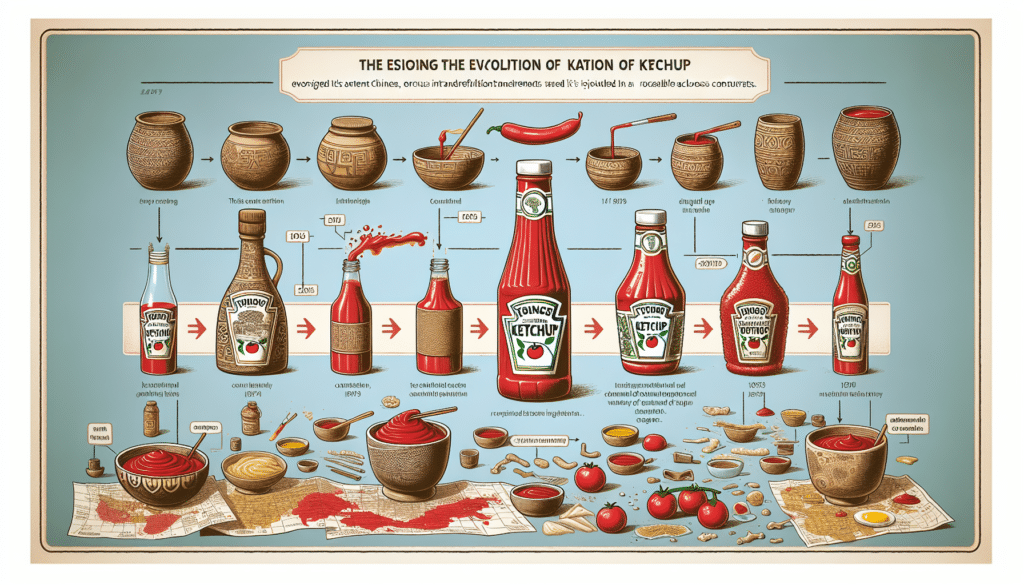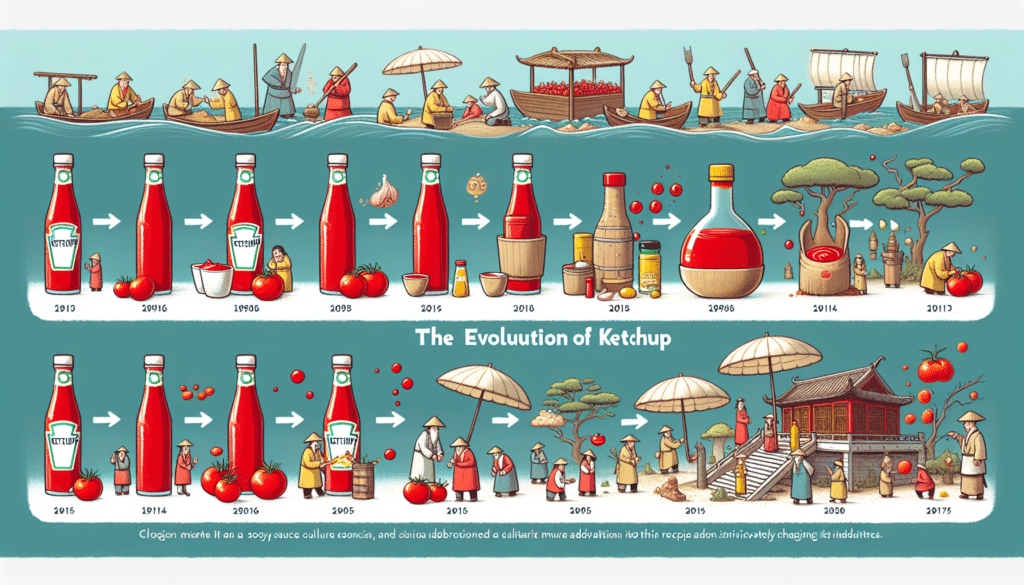Have you ever wondered about the fascinating origins of ketchup? From its humble beginnings to becoming a staple condiment on dining tables around the world, the history of ketchup is truly intriguing. From exploring its roots in ancient China to its transformation in the Western world, this article delves into the captivating journey of how ketchup came to be. Join us on a flavorful adventure as we uncover the fascinating history and evolution of this beloved sauce.

Ketchup, a beloved condiment enjoyed by people around the world, has a fascinating history that spans centuries. From its humble beginnings in ancient China to its modern-day variations, ketchup has evolved and become a staple in many cuisines. This article will delve into the origins of ketchup, its journey through time, and its significance in various cultures.
Ketchup is a tangy and savory sauce that adds flavor and a hint of sweetness to a wide range of dishes. It is typically made from tomatoes, vinegar, sugar, and a blend of spices. However, there are also non-tomato variants that feature ingredients such as mushrooms, walnuts, or even fruits. Ketchup is commonly used as a condiment for hamburgers, french fries, and hot dogs, but its versatility allows for creative usage in cooking and as a dipping sauce.
Ketchup has found its way into numerous culinary creations, both traditional and modern. It is a key ingredient in iconic dishes like the classic American meatloaf, where it adds a tangy depth of flavor to the meat. In Asian cuisines, ketchup is often used as a base for sauces in popular dishes such as sweet and sour chicken. Additionally, it is a go-to sauce for dunking appetizers like chicken nuggets and onion rings. The versatility of ketchup makes it a beloved and essential pantry staple in households worldwide.
The story of ketchup begins in ancient China, where a precursor to the condiment was first made. Known as “ke-tsiap,” this sauce was a mixture of fermented fish, meat, and soybeans. It provided a flavor-enhancing element to various dishes and quickly gained popularity during the Tang Dynasty. This early version of ketchup underwent gradual modifications as it spread to Southeast Asia, eventually reaching Europe and the Americas.
The Romans had their own version of ketchup called “garum,” which was a pungent sauce made from fermented fish, salt, and various herbs. It acted as a condiment to enhance the flavor of their dishes and was often used in Roman cookery. While not directly connected to modern ketchup, the concept of a flavor-boosting sauce resonates with the history of ketchup’s evolution.
During the Middle Ages, ketchups were brewing in Europe, but they were quite different from the ketchup we know today. These early European ketchups were more akin to savory purees or sauces made from ingredients like mushrooms, anchovies, and nuts. They were used to add flavor to meat, fish, and vegetable dishes. The evolution of ketchup took a significant turn when explorers discovered the New World and brought back tomatoes.
The arrival of tomatoes from the New World in the 16th century had a significant impact on ketchup’s evolution. Although initially met with skepticism due to their resemblance to poisonous plants, tomatoes eventually gained acceptance as a food ingredient. Tomatoes were incorporated into ketchup recipes, leading to the birth of tomato ketchup, which would revolutionize the condiment landscape.
The first tomato-based ketchup recipes can be traced back to the late 18th century. They often featured combinations of tomatoes, vinegar, spices, and sugar, aiming to strike a balance between tartness and sweetness. These early recipes were typically homemade and varied regionally in terms of flavors and ingredients, reflecting the availability of local produce and personal preferences.
The commercialization of tomato ketchup started in the early 19th century, with entrepreneurs recognizing its potential as a popular condiment. In 1812, the first commercially produced tomato ketchup hit the market in America. The recipe was developed by James Mease, a Philadelphia scientist, who aimed to capture the essence of homemade ketchup in a bottled form. This paved the way for the mass production and widespread availability of tomato ketchup that we enjoy today.

Before tomato ketchup became the dominant variant, various non-tomato ketchups were popular in the 18th and early 19th centuries. These recipes often relied on ingredients such as mushrooms, walnuts, oysters, or anchovies. For example, walnut ketchup was a common sauce made by infusing walnuts with spices and vinegar. These non-tomato ketchups offered alternative flavors and added depth to culinary creations.
As ketchup continued to evolve, vegetables and fruits beyond tomatoes found their way into recipes, creating a kaleidoscope of flavors. Ingredients such as apples, peaches, and even bananas were utilized in some unconventional ketchup recipes. The inclusion of these fruits and vegetables added a touch of sweetness and complexity to ketchup, expanding its versatility as a condiment.
As the popularity of ketchup grew, it led to the development of numerous other condiments. The flavor profiles and cultural preferences of different regions gave rise to unique sauces like curry ketchup in Germany and banana ketchup in the Philippines. These spin-offs showcased the adaptability and creativity within the condiment landscape, allowing for an array of flavors to satisfy diverse palates around the globe.
The 19th and 20th centuries witnessed the rise of mass production and the advent of bottled ketchup. Innovations in food preservation, such as canning, pasteurization, and the invention of the glass bottle, allowed ketchup to be produced on a larger scale. Bottled ketchup became widely accessible, and its convenient packaging and extended shelf life contributed to its popularity as a pantry staple.
Ketchup’s popularity soared in the United States during the 20th century, becoming an iconic American condiment. With the advent of fast food and the rise of the hamburger and french fries as quintessential American fare, ketchup became inseparable from these beloved dishes. Its sweet tanginess perfectly complements the savory flavors, establishing ketchup as a beloved and essential American condiment.
In addition to its association with fast food, ketchup has become deeply ingrained in American cuisine. It is used as a base for barbecue sauces, as an ingredient in marinades, and as a flavor enhancer in a variety of dishes. From meatloaf to macaroni and cheese, ketchup finds its way into countless recipes, providing a versatile and delicious touch to American cooking.
Ketchup’s journey across borders and into different cultures resulted in fascinating regional adaptations and variations. In countries like China, India, and Indonesia, ketchup has evolved to suit local tastes and flavors. For example, in China, tomato ketchup is often combined with additional ingredients such as soy sauce or chili to create a unique fusion of flavors. These international variations reflect the diverse palates and culinary traditions around the world.
As ketchup assimilated into various regions, local ingredients and preferences played a significant role in the evolution of its flavors. In Thailand, for instance, fish sauce and tamarind are sometimes used in ketchup recipes, adding a distinctive Southeast Asian flair. In Japan, ketchup can be found mixed with mayonnaise, resulting in a creamy and tangy condiment that pairs perfectly with Japanese street food. These regional modifications highlight the adaptability and versatility of ketchup in global cuisine.
Beyond regional adaptations, creative minds have embraced the opportunity to experiment with ketchup flavors, resulting in unique and unconventional varieties. Spicy ketchup, infused with fiery peppers, pleases those with a taste for heat, while fruity ketchups like mango or pineapple cater to those seeking a sweeter twist. These innovative flavors demonstrate the ability to continuously reinvent ketchup to cater to diverse palates and preferences.

Over the years, ketchup’s popularity has grown exponentially, leading to an expanding market and increased industrialization. Major ketchup brands emerged, utilizing sophisticated production methods and marketing campaigns to capture consumer attention. The availability of ketchup increased globally, making it a pantry staple in households and restaurants across continents.
Major ketchup brands have played a pivotal role in shaping the perception and consumption patterns of ketchup worldwide. Brands like Heinz, Hunt’s, and Del Monte have become synonymous with quality and consistency, creating a sense of trust among consumers. Their commitment to maintaining the original essence of ketchup while introducing innovative flavors has contributed to the longevity and market dominance of these brands.
Today, ketchup has achieved worldwide recognition and consumption patterns vary significantly from country to country. In the United States, ketchup consumption remains exceptionally high, particularly in fast-food chains and family restaurants. Meanwhile, countries like the United Kingdom, Germany, and Canada have their own unique ketchup preferences. The global reach of ketchup illustrates its ability to adapt, evolve, and become an integral part of diverse culinary traditions.
The widespread use of high-fructose corn syrup (HFCS) in commercial ketchup has sparked concerns about its impact on health. HFCS, a sweetener derived from corn, is often used to enhance the sweetness of ketchup. However, excessive consumption of HFCS has been linked to a range of health problems, including obesity and diabetes. In response to these concerns, some brands have started offering healthier alternatives with reduced sugar content or natural sweeteners.
As health-consciousness continues to rise, so does the demand for healthier ketchup alternatives. Many brands now offer organic ketchup, which is made from organic tomatoes and free from synthetic additives. Additionally, low-sodium and no added sugar ketchup have gained popularity, catering to those seeking a lower-salt or sugar-free diet. These adaptations allow individuals to enjoy the tangy goodness of ketchup with their health in mind.
Ketchup manufacturers have recognized the importance of catering to individuals with specific dietary needs. Consequently, many brands now offer gluten-free, vegan, and allergen-friendly ketchups. By adapting their recipes and manufacturing processes, these brands ensure that everyone can enjoy the iconic taste of ketchup, regardless of their dietary restrictions or preferences.
While ketchup is traditionally associated with burgers and fries, people have found creative and unexpected combinations that highlight its versatility. Some daring individuals enjoy ketchup with their morning eggs, while others mix it with mayonnaise to create a popular dipping sauce known as “fry sauce.” Unusual as it may sound, these unique ketchup pairings demonstrate the countless ways this beloved condiment can be enjoyed.
Ketchup has made its mark in history through various record-breaking feats. In 2001, a massive ketchup bottle, standing at 15 feet tall, was unveiled in the United States, claiming the Guinness World Record for the largest ketchup bottle. Additionally, the fastest time to empty a bottle of ketchup was achieved in 33.05 seconds by a contestant, leaving us in awe of the dexterity and determination it takes to accomplish such a task.
Ketchup has permeated popular culture, making appearances in movies, television shows, and even songs. Films like “Forrest Gump” and television shows like “Friends” have featured memorable ketchup-related scenes, adding to its iconic status in everyday life. Moreover, ketchup-themed merchandise, from t-shirts to kitchen accessories, allows fans to celebrate their love for this timeless condiment.
From its humble origins in ancient China to its modern-day status as a global condiment, the history of ketchup is a testament to its enduring appeal. This tangy and versatile sauce has captivated taste buds and played a flavorful role in numerous culinary traditions worldwide. As ketchup continues to evolve, adapt, and innovate, one thing remains constant – its ability to bring joy and enhance the flavor of countless dishes. So next time you reach for that bottle of ketchup, take a moment to appreciate the rich history and cultural significance behind this beloved condiment.